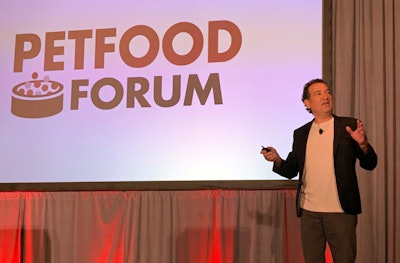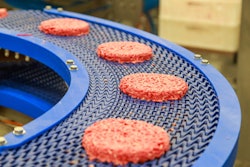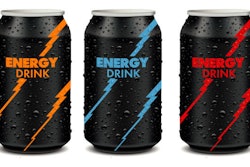
Are you barking up the right tree? If you want to know what might be coming down the pike in pet food, take a look at what the trends are now in people food, notes Daniel Levine, director of the Avant-Guide Institute and this morning’s keynote speaker at the Petfood Forum in Kansas City.
Besides that No. 1, overarching trend, Levine detailed five other key trends that will likely be shaped in much the same way as we bring to our pets the same features that we seek for ourselves: functionality, transparency, humanification, convenience, and technology.
Some key trends Levine points to within people food that are likely to migrate to our pets are individually packaged snacks and hydration. “We’re seeing more and more that humans are blurring the lines between meals and eating smaller foods during the day,” he says. “If there’s an analog in the pet food industry, we can imagine that snacking is a growing part of the pet food industry also.”
 | Live at Petfood Essentials: Pet Snacks Put Emphasis on Health, Safety |
If there’s something that trends do, it’s grow, Levine adds. So it’s easy to see that snacking for pets will grow over the next few years, along with human snacking. It’s also easy to see that the trend toward single-serve packaging will likely move into the pet aisle as well.
Pointing to a growing trend for humans to go after more personalized hydration choices, Levine expects people to make the same kinds of choices for their pets. Waters with special properties—high-alkaline waters, for example, to help with bones and digestion—could be making their way to pets. It’s part of a growing propensity toward functional foods and beverages.
The pet food market for functional foods and beverages looks to be moving in sync with the human market. “Sometimes when we see products, we’re not sure if they’re for humans or for pets,” Levine says, pointing to a picture of Digest Gold Fiber+ Cookies from Enzymedica (honestly, I’m still confused, since these appear to be for human consumption). But then he also referenced a growth in CBD products for pets, to help with calming or joint health.
 Trends toward functional treats for pets include CBD products for their calming effects.bSerene
Trends toward functional treats for pets include CBD products for their calming effects.bSerene
“As with everything else in these trends, it’s getting more and more intense. We’re seeing more products that do more for you and are being marketed in that way,” Levine says. “It’s incredible how quick this market is moving. The idea of functionality is also about longevity. And I would say one of the biggest trends that we will be seeing in the next year or two for people has to do with the idea of Blue Zones.”
Blue Zones are places in the world where people are living the longest—places like Sardinia, Italy; Okinawa, Japan; Nicoya, Costa Rica; Ikaria, Greece; and Loma Linda, Calif. Referencing a frozen food line, Blue Zones Kitchen, that just came out a few weeks ago for humans, Levine comments, “It would make sense to me, as a trends person in that space, to see the same concept moving over into the pet food market.”
And be transparent about it
Many of the trends that Levine detailed in the rest of his talk relate to transparency—in that pet food companies not only need to make moves toward functionality, sustainability, etc., but also help customers see what they’re doing and how they’re doing it.
“Transparency is the idea is that our customers are talking about us and they see through us,” Levine says. “It used to be, before the internet, before social media, that companies and brands could tell their customers all about themselves, and that was it. That’s the main information that customers got. But of course, now customers are sharing, and it’s snowballed in such a way that customers are sharing what’s really good and what’s really bad about different products and services.”
Perhaps nowhere is transparency more important these days than in what companies are doing around sustainability. Pet food makers would be well served to pay attention to what’s being done in other industries, including the human food market, to show consumers what they’re doing to make their products more sustainable.
Examples include Safe Catch tuna, which tells consumers on its label that it has a lower mercury content than other brands; and Bumble Bee tuna, which provides a QR code that consumers can scan to find out more about how the tuna was sustainably caught. Levine has seen labels on wagyu beef from Japan, and even edible QR codes on individual pieces of sushi. “Is that too much information on your sushi?” he asks. “Probably. But it’s a good example for this idea of transparency.”
Another trend connected to the others is what Levine calls humanification—making pet foods look more like human foods, helping pet parents better share their experiences with their pets. “It’s been growing year by year, and I suspect it’s going to continue growing in years to come,” Levine says.
 Dog Yurt, a single-serve non-dairy yogurt for dogs that even includes mix-ins, is an example of the humanification of pet foods.
Dog Yurt, a single-serve non-dairy yogurt for dogs that even includes mix-ins, is an example of the humanification of pet foods.
In Japan, you can buy sushi rolls that look just like yours. “Or let’s say you’re somebody who just absolutely loves Mexican food. You can share a burrito bowl with your dog,” Levine says. “We’re seeing a bunch of different products and brands come up with coffee for dogs. So you can share a cup of coffee with your dog.”
Don’t worry, there’s no caffeine. After all the treats, though, it might be time to reach for the Ozempic.
“Ozempic is already changing the world of people food and changing how much people eat. It’s changing what they buy. It’s changing the way that they think about their foods,” Levine says. “And of course, if you think about people foods being a leading indicator to pet foods, it’s easy to imagine that Ozempic and GLP-1 agonists, which is the category that Ozempic is in, will be changing pets as well. We’re already seeing some vets are prescribing Ozempic for cats and dogs.”
Our cultured pets
Most of Levine’s keynote was about pets following in our footsteps—with the trends we’re seeing in human foods today becoming the pet food trends of tomorrow. But in one area, he says, pets are leading the way.
That’s cultivated meat, which looks to be a long way off still from achieving the kind of scale needed to reach the public in any sort of meaningful way. “In the people food business, the lab grown meat is something that we’re probably not going to see for quite a long time—10 years, 20 years. And what’s so interesting is that the pet food industry seems to be leading in what’s happening with these kinds of foods. The reason mainly being because you can culture cells that would make a slurry that might taste good to pets or look OK for pets, but doesn’t quite have the structure that humans need and desire that can be created in a massive way,” Levine says. “But we’re starting to see in the pet food industry already several brands, especially in the last few months, are popping up that are creating cultured meat foods for our animals.”
Marina Cat, for example, is a cat treat made with cultivated snapper. “They’re promoting it as the world’s first cell-cultivated cat treat,” he says.


















